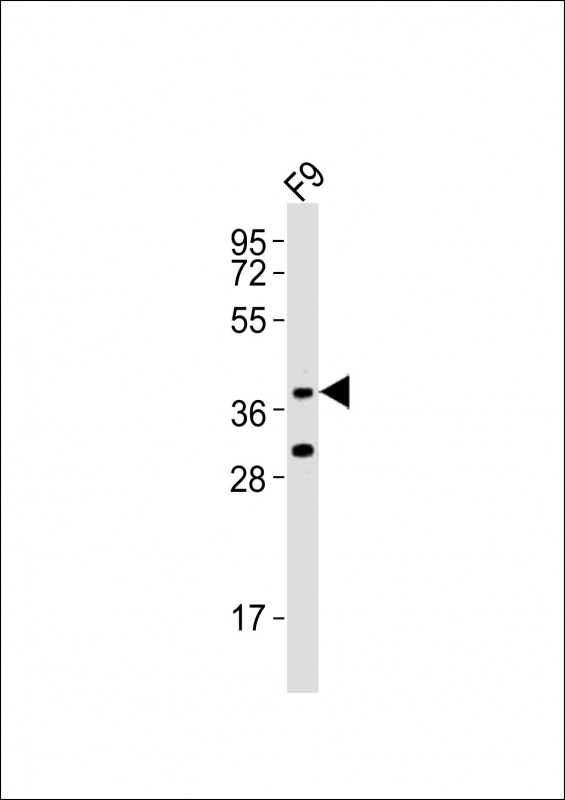(Mouse) Rnf2 Antibody (Center)
Purified Rabbit Polyclonal Antibody (Pab)
- 产品详情
- 实验流程
- 背景知识
Application
| WB, E |
|---|---|
| Primary Accession | Q9CQJ4 |
| Reactivity | Human, Rat, Mouse |
| Host | Rabbit |
| Clonality | polyclonal |
| Isotype | Rabbit IgG |
| Calculated MW | 37623 Da |
| Gene ID | 19821 |
|---|---|
| Other Names | E3 ubiquitin-protein ligase RING2, 632-, RING finger protein 1B, RING1b, RING finger protein 2, Rnf2, DinG, Ring1b |
| Target/Specificity | This mouse Rnf2 antibody is generated from a rabbit immunized with a KLH conjugated synthetic peptide between 165-199 amino acids from the Central region of mouse Rnf2. |
| Dilution | WB~~1:2000 E~~Use at an assay dependent concentration. |
| Format | Purified polyclonal antibody supplied in PBS with 0.09% (W/V) sodium azide. This antibody is purified through a protein A column, followed by peptide affinity purification. |
| Storage | Maintain refrigerated at 2-8°C for up to 2 weeks. For long term storage store at -20°C in small aliquots to prevent freeze-thaw cycles. |
| Precautions | (Mouse) Rnf2 Antibody (Center) is for research use only and not for use in diagnostic or therapeutic procedures. |
| Name | Rnf2 |
|---|---|
| Synonyms | DinG, Ring1b |
| Function | E3 ubiquitin-protein ligase that mediates monoubiquitination of 'Lys-119' of histone H2A (H2AK119Ub), thereby playing a central role in histone code and gene regulation (PubMed:15525528, PubMed:22325148, PubMed:28596365). H2AK119Ub gives a specific tag for epigenetic transcriptional repression and participates in X chromosome inactivation of female mammals (PubMed:15525528, PubMed:28596365). May be involved in the initiation of both imprinted and random X inactivation (PubMed:15525528). Essential component of a Polycomb group (PcG) multiprotein PRC1-like complex, a complex class required to maintain the transcriptionally repressive state of many genes, including Hox genes, throughout development (PubMed:16710298, PubMed:22325148). PcG PRC1 complex acts via chromatin remodeling and modification of histones, rendering chromatin heritably changed in its expressibility (PubMed:15525528, PubMed:16710298, PubMed:22325148). E3 ubiquitin-protein ligase activity is enhanced by BMI1/PCGF4 (PubMed:16710298). Acts as the main E3 ubiquitin ligase on histone H2A of the PRC1 complex, while RING1 may rather act as a modulator of RNF2/RING2 activity (PubMed:15525528, PubMed:16710298). Plays a role in the transcriptional repression of genes that are required for pluripotency in embryonic stem cells, thereby contributing to differentiation of the ectodermal and endodermal germ layers (PubMed:22226355). Association with the chromosomal DNA is cell-cycle dependent. In resting B- and T-lymphocytes, interaction with AURKB leads to block its activity, thereby maintaining transcription in resting lymphocytes (PubMed:24034696). Also acts as a negative regulator of autophagy by mediating ubiquitination of AMBRA1, leading to its subsequent degradation (PubMed:24980959). |
| Cellular Location | Nucleus. Cytoplasm Chromosome Note=Enriched on inactive X chromosome (Xi) in female trophoblast stem (TS) cells as well as differentiating embryonic stem (ES) cells (PubMed:12183370). The enrichment on Xi is transient during TS and ES cell differentiation. The association with Xi is mitotically stable in non-differentiated TS cells (PubMed:12183370). Co-localizes with SAMD7 in nuclear polycomb bodies (PubMed:28900001) |
| Tissue Location | Expressed in embryonic stem cells. |
For Research Use Only. Not For Use In Diagnostic Procedures.
Provided below are standard protocols that you may find useful for product applications.
BACKGROUND
E3 ubiquitin-protein ligase that mediates monoubiquitination of 'Lys-119' of histone H2A (H2AK119Ub), thereby playing a central role in histone code and gene regulation. H2AK119Ub gives a specific tag for epigenetic transcriptional repression and participates in X chromosome inactivation of female mammals. May be involved in the initiation of both imprinted and random X inactivation. Essential component of a Polycomb group (PcG) multiprotein PRC1-like complex, a complex class required to maintain the transcriptionally repressive state of many genes, including Hox genes, throughout development. PcG PRC1 complex acts via chromatin remodeling and modification of histones, rendering chromatin heritably changed in its expressibility. E3 ubiquitin-protein ligase activity is enhanced by BMI1/PCGF4. Acts as the main E3 ubiquitin ligase on histone H2A of the PRC1 complex, while RING1 may rather act as a modulator of RNF2/RING2 activity. Association to the chromosomal DNA is cell-cycle dependent. In resting B- and T-lymphocytes, interaction with AURKB leads to block its activity, thereby maintaining transcription in resting lymphocytes.
REFERENCES
Schoorlemmer J.,et al.EMBO J. 16:5930-5942(1997).
Carninci P.,et al.Science 309:1559-1563(2005).
Ebert L.,et al.Submitted (JUL-2005) to the EMBL/GenBank/DDBJ databases.
Garcia E.,et al.EMBO J. 18:3404-3418(1999).
Suzuki M.,et al.Development 129:4171-4183(2002).
终于等到您。ABCEPTA(百远生物)抗体产品。
点击下方“我要评价 ”按钮提交您的反馈信息,您的反馈和评价是我们最宝贵的财富之一,
我们将在1-3个工作日内处理您的反馈信息。
如有疑问,联系:0512-88856768 tech-china@abcepta.com.























 癌症的基本特征包括细胞增殖、血管生成、迁移、凋亡逃避机制和细胞永生等。找到癌症发生过程中这些通路的关键标记物和对应的抗体用于检测至关重要。
癌症的基本特征包括细胞增殖、血管生成、迁移、凋亡逃避机制和细胞永生等。找到癌症发生过程中这些通路的关键标记物和对应的抗体用于检测至关重要。 为您推荐一个泛素化位点预测神器——泛素化分析工具,可以为您的蛋白的泛素化位点作出预测和评分。
为您推荐一个泛素化位点预测神器——泛素化分析工具,可以为您的蛋白的泛素化位点作出预测和评分。 细胞自噬受体图形绘图工具为你的蛋白的细胞受体结合位点作出预测和评分,识别结合到自噬通路中的蛋白是非常重要的,便于让我们理解自噬在正常生理、病理过程中的作用,如发育、细胞分化、神经退化性疾病、压力条件下、感染和癌症。
细胞自噬受体图形绘图工具为你的蛋白的细胞受体结合位点作出预测和评分,识别结合到自噬通路中的蛋白是非常重要的,便于让我们理解自噬在正常生理、病理过程中的作用,如发育、细胞分化、神经退化性疾病、压力条件下、感染和癌症。







